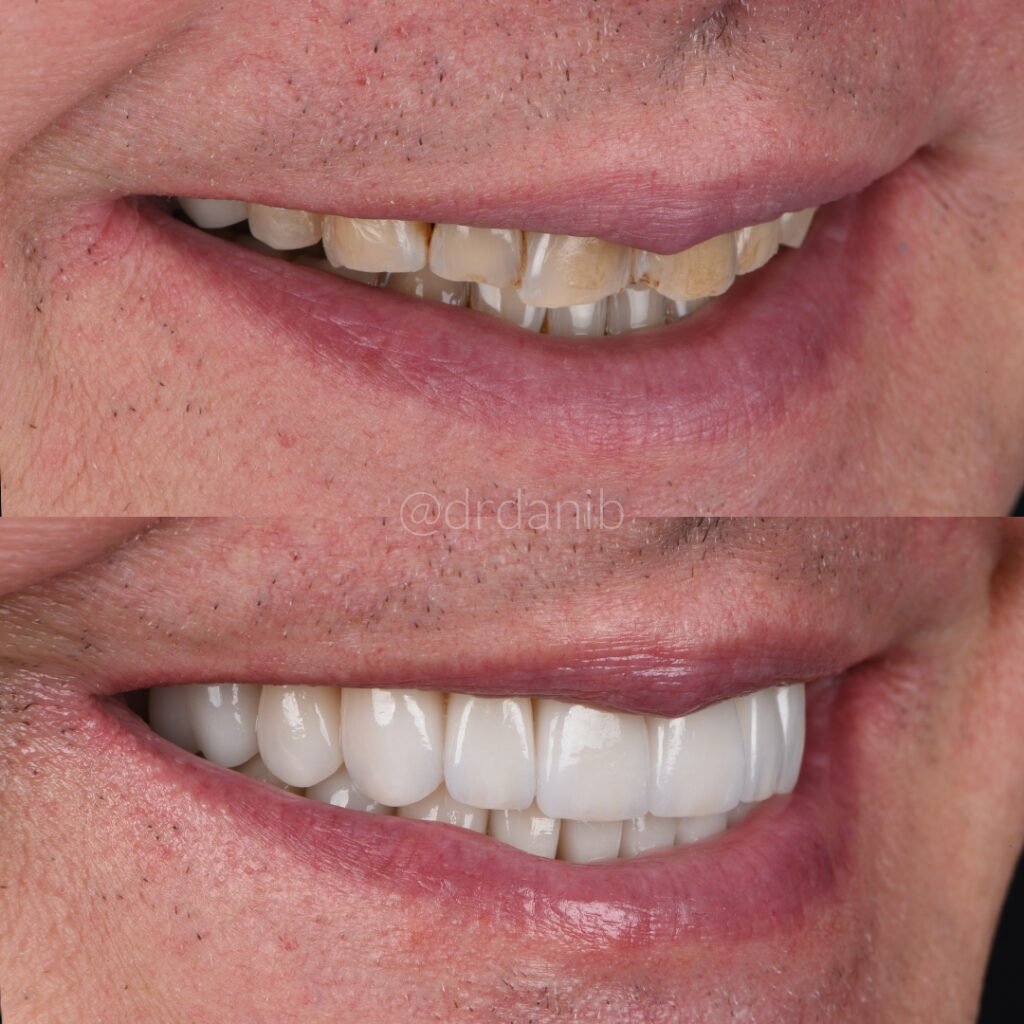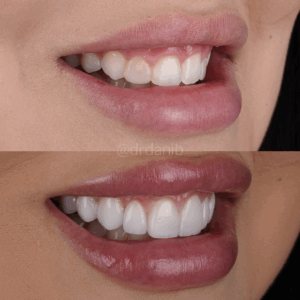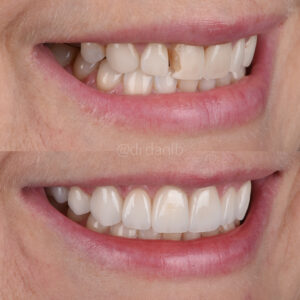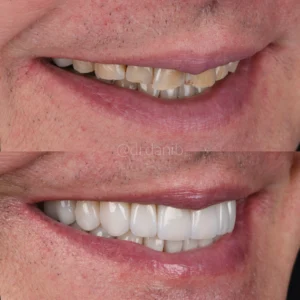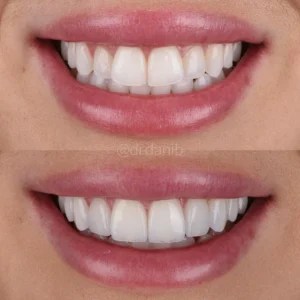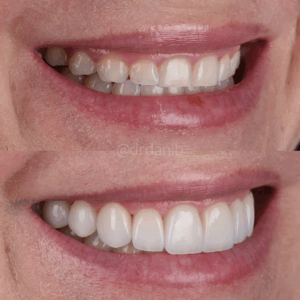Veneers have become a popular cosmetic dental solution for those seeking to improve the appearance of their teeth and smile. These thin, custom-made shells are applied to the front surface of teeth, covering stains, chips, gaps, misalignment, and other imperfections. Veneers are highly sought after by many for quickly and effectively enhancing the appearance of smiles.
Over the years, Dr. Dani B. has been recognized as a Los Angeles veneers specialist. For those seeking an expert opinion on cosmetic dentistry in Los Angeles, Beverly Hills, West Los Angeles, and California, we share Dr. Dani B.’s general overview of veneers.
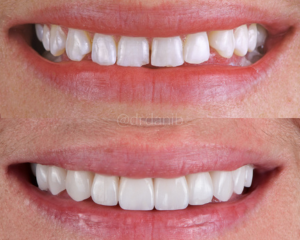
There are two primary types of veneers available: no-prep and minimal-prep. Both options offer significant benefits. It’s essential to understand the key differences between the two methods before deciding. Keep reading to explore the differences and choose the best option for your personalized smile goals.
What are Veneers?
Veneers are a popular cosmetic dental treatment designed to enhance the appearance of your smile. They are thin, custom-made shells that are applied to the front surface of your teeth to cover imperfections such as stains, chips, gaps, or misalignment.
Materials Used
Veneers are made from porcelain, a highly durable and lifelike material that closely resembles the natural appearance of teeth. Porcelain veneers are known for their strength, stain resistance, and ability to blend seamlessly with your existing teeth.
Traditional Veneers vs. No-Prep and Minimal Prep
There are three main types of veneers:
- Traditional Veneers require significant tooth preparation, involving the removal of a thin layer of enamel from the front surface of your teeth. This creates a space for the veneer to be bonded securely.
- No-Prep Veneers do not require any tooth preparation. They are bonded directly to the surface of your teeth without removing any enamel.
- Minimal Prep Veneers involve minimal tooth preparation. A veneers specialist removes a very thin layer of enamel before applying the veneers. Minimal prep veneers are a less invasive alternative to traditional veneers.
No-Prep Veneers
No-prep veneers are a type of veneer that requires little to no removal of natural tooth structure. This makes them a less invasive and more acceptable option than traditional veneers.
The application of no-prep veneers is a relatively straightforward procedure. Dr. Dani B. will make a minimal alteration to the tooth surface to ensure proper bonding. The veneers are then bonded directly to the tooth surface using a special adhesive.
Advantages
- Preservation of Natural Tooth Structure: No-prep veneers minimize the need to remove enamel from your teeth, helping to preserve their natural structure.
- Less Invasive and Quicker Application: The procedure is less invasive than traditional veneers, often requiring fewer appointments and less discomfort.
- Reversible in Some Cases: In certain situations, no-prep veneers can be removed without causing significant damage to the teeth, providing a degree of reversibility.
Disadvantages
- May Not Be Suitable for Some Patients: Individuals with thicker teeth or those seeking to correct major cosmetic issues or alignment may be better suited for alternative cosmetic treatments.
- Limited Ability to Correct Major Cosmetic Issues or Alignment: Less tooth enamel is removed, making them ideal for minor cosmetic concerns.
- May Not Last as Long as Traditional Veneers: Their thin structure and low preparation process reduce their lifespan.
Ideal Candidates
No-prep veneers are well-suited for patients with minor smile flaws, such as stains or small gaps. They are also ideal for individuals seeking a conservative cosmetic dental solution that preserves their natural tooth structure.
Minimal Prep Veneers
Minimal prep veneers require slight teeth reshaping or minimal enamel removal. This option balances the advantages of traditional veneers and no-prep veneers.
To apply minimal prep veneers, a porcelain veneers specialist will remove a small amount of enamel from the front surface of your teeth, typically about 0.3-0.5 mm. This allows for a better fit and a more natural-looking result. The veneers are then custom-made and bonded to the prepared tooth surface.
Advantages
- Allows for Better Fitting and More Natural-Looking Results: Minimal prep veneers provide a more customized fit and create a more aesthetically pleasing appearance than no-prep veneers.
- Can Address More Significant Cosmetic Concerns: This option is suitable for addressing larger gaps, crooked teeth, or other more pronounced cosmetic issues.
- Longer-Lasting than No-Prep Veneers: Minimal prep veneers, with their slightly more invasive procedure, can often provide a longer-lasting result than no-prep veneers.
Disadvantages
- Irreversible (Enamel Removal Cannot Be Undone): Once the enamel is removed, it cannot be restored. This means that minimal prep veneers are not reversible.
- More Invasive than No-Prep Veneers: While minimal prep veneers are less invasive than traditional veneers, they are still more invasive than no-prep veneers.
Ideal Candidates
Minimal prep veneers are ideal for patients with moderate cosmetic issues who desire a more customizable and durable result compared to no-prep veneers. They are also suitable for individuals who want to address more significant dental concerns that can be effectively corrected with no-prep veneers.
Summary of Key Differences Between No-Prep and Minimal Prep Veneers
Tooth Preparation
- No-Prep Veneers: These veneers typically require no or minimal enamel removal, making them the least invasive option.
- Minimal Prep Veneers: This type of veneer requires slight reshaping of the tooth surface and removing a small amount of enamel.
Aesthetic Results
- No-Prep Veneers: While effective for minor cosmetic issues, no-prep veneers may have limitations in achieving more precise customization, especially for larger cosmetic concerns.
- Minimal Prep Veneers: The slight enamel removal allows for a more customized fit and can deliver more natural-looking results, particularly for patients with more significant dental issues.
Durability
- No-Prep Veneers: While no-prep veneers can provide good results, minimal prep veneers are generally more durable due to their better adhesion and the slightly thicker material used.
- Minimal Prep Veneers: The additional tooth preparation involved in minimal prep veneers can lead to stronger and more long-lasting results.
Invasiveness
- No-Prep Veneers: These veneers are the least invasive option, requiring minimal or no tooth preparation.
- Minimal Prep Veneers: While still relatively minimally invasive, minimal prep veneers involve a slight reduction in tooth structure compared to no-prep veneers.
Suitability
- No-Prep Veneers: Patients with minor cosmetic concerns, such as stains or small gaps, are often good candidates for no-prep veneers.
- Minimal Prep Veneers: Individuals with more complex dental issues, such as larger gaps, crooked teeth, or significant discoloration, may benefit from minimal prep veneers for more comprehensive results.
Maintenance and Care for Veneers
Proper Oral Hygiene Practices
To ensure the longevity and beauty of your veneers, you should maintain proper oral hygiene practices. This includes:
- Brushing: Brush your teeth twice a day with a soft-bristled toothbrush and fluoride toothpaste.
- Flossing: Floss daily to remove food particles and plaque from between your teeth.
- Regular Dental Check-ups with your veneers specialist: Schedule regular dental check-ups to monitor the health of your veneers and address any potential issues.
Habits
Certain habits can shorten the lifespan of your veneers. It’s important to avoid:
- Teeth Grinding: Grinding your teeth can put excessive stress on your veneers and lead to chipping or cracking.
- Biting Hard Objects: Avoid biting into hard objects, such as ice or candy, as this can damage your veneers.
Lifespan and Durability Considerations
- No-Prep Veneers: While no-prep veneers can be durable, they may not last as long as minimal prep veneers due to their less invasive nature.
- Minimal Prep Veneers: Minimal prep veneers generally have a longer lifespan due to the stronger bond provided by the slight enamel removal.
However, the durability of both types of veneers also depends on proper care and maintenance. By following the recommended oral hygiene practices and avoiding harmful habits, provided by the veneers specialist, you can significantly extend the lifespan of your veneers.
Choosing the Right Option
When deciding between no-prep and minimal prep veneers, several factors should be considered:
- Cosmetic Goals: What level of improvement are you seeking? No-prep veneers are ideal for minor imperfections, while minimal prep veneers can address more significant issues.
- Budget: No-prep veneers generally have a lower cost than minimal prep veneers due to the reduced preparation.
- Tooth Condition: Your veneer specialist will assess the health and condition of your teeth to determine which option is best suited for your specific case.
If you are seeking a veneers expert in Los Angeles, consult with Dr. Dani B., a renowned cosmetic dentist in Southern California. He will carefully evaluate your cosmetic dental needs and provide tailored advice to help you achieve your desired aesthetic goals.
Conclusion
In summary, no-prep and minimal prep veneers offer distinct advantages and disadvantages. No-prep veneers are less invasive but may have limitations in addressing major cosmetic concerns, while minimal prep veneers provide a more customized fit and can address more significant dental issues.
The best veneer option for you will depend on your individual needs, dental health, and cosmetic goals. By consulting with Dr. Dani B. in Los Angeles., you can make an informed decision and achieve the smile you’ve always dreamed of. Ready to transform your smile? Schedule a virtual or in-person consultation with Dr. Dani B. today!


